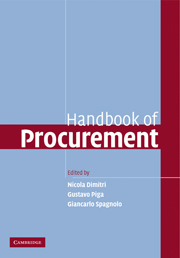Book contents
- Frontmatter
- Contents
- List of figures
- List of tables
- List of contributors
- Preface
- Part I Preliminary Issues
- Part II General Strategic Principles
- Part III Competitive Tendering Strategies
- Part IV Attracting and Screening Participants
- Part V Preventing Collusion and Corruption
- Part VI Dynamic Forces and Innovation
- 17 Managing dynamic procurements
- 18 Designing reputation mechanisms
- 19 Procuring innovations
- Glossary
- Index
- References
19 - Procuring innovations
Published online by Cambridge University Press: 04 November 2009
- Frontmatter
- Contents
- List of figures
- List of tables
- List of contributors
- Preface
- Part I Preliminary Issues
- Part II General Strategic Principles
- Part III Competitive Tendering Strategies
- Part IV Attracting and Screening Participants
- Part V Preventing Collusion and Corruption
- Part VI Dynamic Forces and Innovation
- 17 Managing dynamic procurements
- 18 Designing reputation mechanisms
- 19 Procuring innovations
- Glossary
- Index
- References
Summary
Introduction
Innovation is a key source of competitive advantage, for both firms and nations. Though internal research and development (R&D) is widely acknowledged as a primary source of innovation, it is less often remarked that a firm can secure innovative products from its suppliers. Innovative procurement is somewhat hidden in the popular press, but practitioners know all too well that a carefully designed procurement policy is often the key to success in the most innovative markets. The recent history of the Formula One championship nicely demonstrates how crucial the role of suppliers and procurement of innovative goods can be in determining a firm's eventual success or failure. In our ‘age of outsourcing’, in which all non-core activities are increasingly being outsourced, firms must know how best to procure innovative inputs from strategic suppliers. This involves selecting the suppliers, choosing how to reward them, designing property rights for on-demand innovation, and ensuring that suppliers do not gain too much bargaining power, creating hold-up problems.
On the other hand, public procurement can strongly impact firms’ profitability in innovative industries. It is well known, for example, that the US government's defence procurement has been a major driving force for the development of such innovations as large passenger jets, semiconductors, and the Internet. These examples highlight that public procurement mechanisms can play a crucial role in stimulating or hampering private innovative activity.
- Type
- Chapter
- Information
- Handbook of Procurement , pp. 483 - 529Publisher: Cambridge University PressPrint publication year: 2006
References
- 22
- Cited by



